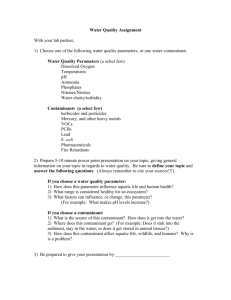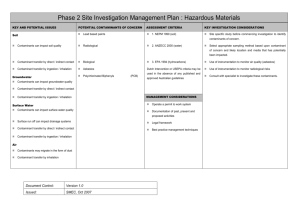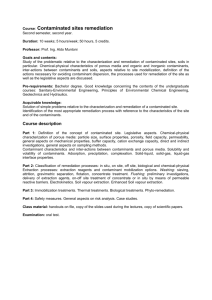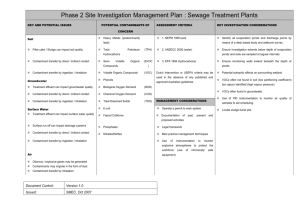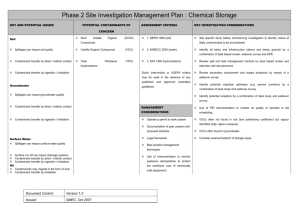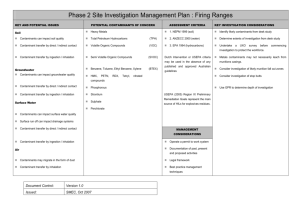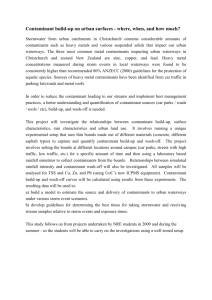************************************************************************** USACE / NAVFAC / AFCEC / NASA ...
advertisement
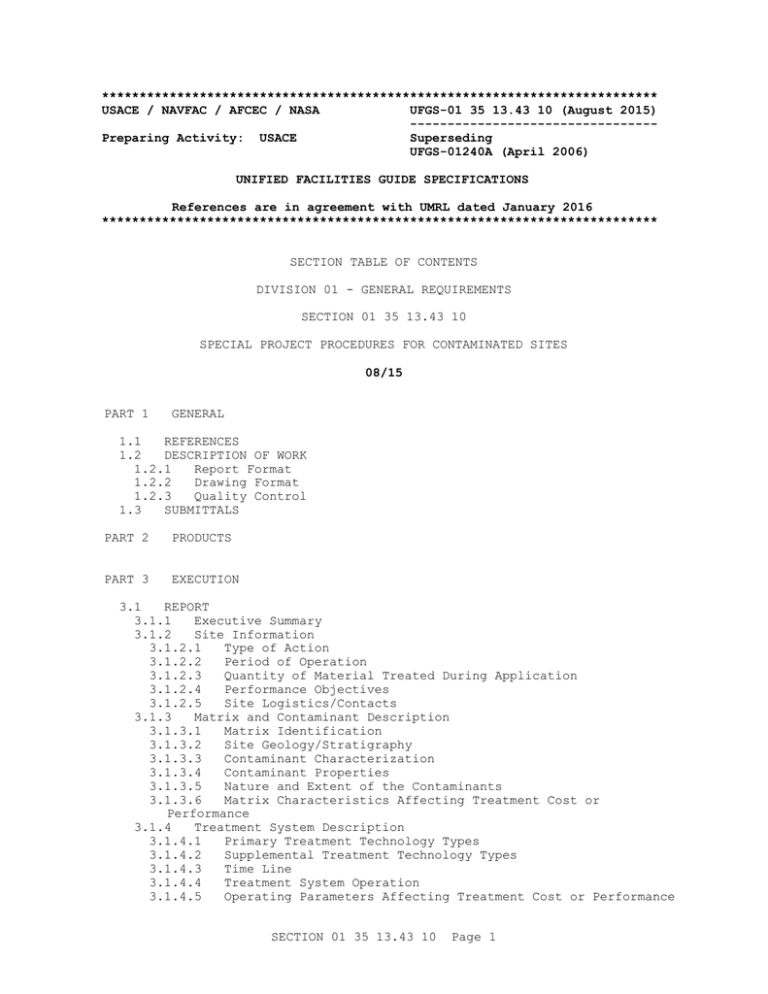
************************************************************************** USACE / NAVFAC / AFCEC / NASA UFGS-01 35 13.43 10 (August 2015) --------------------------------Preparing Activity: USACE Superseding UFGS-01240A (April 2006) UNIFIED FACILITIES GUIDE SPECIFICATIONS References are in agreement with UMRL dated January 2016 ************************************************************************** SECTION TABLE OF CONTENTS DIVISION 01 - GENERAL REQUIREMENTS SECTION 01 35 13.43 10 SPECIAL PROJECT PROCEDURES FOR CONTAMINATED SITES 08/15 PART 1 GENERAL 1.1 REFERENCES 1.2 DESCRIPTION OF WORK 1.2.1 Report Format 1.2.2 Drawing Format 1.2.3 Quality Control 1.3 SUBMITTALS PART 2 PRODUCTS PART 3 EXECUTION 3.1 REPORT 3.1.1 Executive Summary 3.1.2 Site Information 3.1.2.1 Type of Action 3.1.2.2 Period of Operation 3.1.2.3 Quantity of Material Treated During Application 3.1.2.4 Performance Objectives 3.1.2.5 Site Logistics/Contacts 3.1.3 Matrix and Contaminant Description 3.1.3.1 Matrix Identification 3.1.3.2 Site Geology/Stratigraphy 3.1.3.3 Contaminant Characterization 3.1.3.4 Contaminant Properties 3.1.3.5 Nature and Extent of the Contaminants 3.1.3.6 Matrix Characteristics Affecting Treatment Cost or Performance 3.1.4 Treatment System Description 3.1.4.1 Primary Treatment Technology Types 3.1.4.2 Supplemental Treatment Technology Types 3.1.4.3 Time Line 3.1.4.4 Treatment System Operation 3.1.4.5 Operating Parameters Affecting Treatment Cost or Performance SECTION 01 35 13.43 10 Page 1 3.1.5 Treatment System Performance 3.1.5.1 Treatment Performance Data 3.1.5.2 Data Assessment and Deviations from Standard Performance 3.1.5.3 Material Balances 3.1.5.4 Target Contaminant and Operating Conditions 3.1.5.5 Target Contaminant and Removal Efficiencies 3.1.5.6 Characteristics of Treated Material 3.1.6 Performance Data Quality 3.1.7 Treatment System Cost 3.1.7.1 HTRW - Remedial Action Work Breakdown Structure 3.1.7.2 Pre-Treatment Costs 3.1.7.3 Costs Directly Associated with Treatment 3.1.7.4 Post-Treatment Costs 3.1.8 Regulatory/Institutional Issues 3.1.9 Observations and Lessons Learned 3.1.9.1 Cost Observations and Lessons Learned 3.1.9.2 Performance Observations and Lessons Learned 3.1.9.3 Other Observations and Lessons Learned ATTACHMENTS: Cost and Performance Report -- End of Section Table of Contents -- SECTION 01 35 13.43 10 Page 2 ************************************************************************** USACE / NAVFAC / AFCEC / NASA UFGS-01 35 13.43 10 (August 2015) --------------------------------Preparing Activity: USACE Superseding UFGS-01240A (April 2006) UNIFIED FACILITIES GUIDE SPECIFICATIONS References are in agreement with UMRL dated January 2016 ************************************************************************** SECTION 01 35 13.43 10 SPECIAL PROJECT PROCEDURES FOR CONTAMINATED SITES 08/15 ************************************************************************** NOTE: This guide specification covers the requirements for preparing a cost and performance documentation report on environmental remediation projects. Adhere to UFC 1-300-02 Unified Facilities Guide Specifications (UFGS) Format Standard when editing this guide specification or preparing new project specification sections. Edit this guide specification for project specific requirements by adding, deleting, or revising text. For bracketed items, choose applicable items(s) or insert appropriate information. Remove information and requirements not required in respective project, whether or not brackets are present. Comments, suggestions and recommended changes for this guide specification are welcome and should be submitted as a Criteria Change Request (CCR). ************************************************************************** PART 1 GENERAL ************************************************************************** NOTE: The work covered by this section will be restricted to report preparation. No design, construction, operation or maintenance requirements are included herein. The specifier or designer will include available information and data or provide appropriate references to prevent remedial action Contractor from duplicating previous efforts. ************************************************************************** 1.1 REFERENCES ************************************************************************** NOTE: This paragraph is used to list the publications cited in the text of the guide SECTION 01 35 13.43 10 Page 3 specification. The publications are referred to in the text by basic designation only and listed in this paragraph by organization, designation, date, and title. Use the Reference Wizard's Check Reference feature when you add a RID outside of the Section's Reference Article to automatically place the reference in the Reference Article. Also use the Reference Wizard's Check Reference feature to update the issue dates. References not used in the text will automatically be deleted from this section of the project specification when you choose to reconcile references in the publish print process. ************************************************************************** The publications listed below form a part of this specification to the extent referenced. The publications are referred to within the text by the basic designation only. FEDERAL REMEDIATION TECHNOLOGIES ROUNDTABLE (FRTR) USAEC SFIM-AEC-ET-CR-97053 (2007) Federal Remediation Technologies Screening Matrix and Reference Guide, Fourth Edition U.S. ARMY CORPS OF ENGINEERS (USACE) EP 1110-1-19 (2001) A Guide to Preparing and Reviewing Remedial Action Reports of Cost and Performance ER 1110-3-1301 (1999) Engineering and Design -- Cost Engineering Policy Requirements for Hazardous, Toxic Radioactive Waste (HTRW) Cost Engineering U.S. ENVIRONMENTAL PROTECTION AGENCY (EPA) EPA 542-B-98-007 1.2 (1998) Guide to Documenting and Managing Cost and Performance Information for Remediation Projects DESCRIPTION OF WORK Work consists of the preparation of a report containing cost and performance data from the [_____] environmental remediation project. Use the [partial] [draft] [_____] [Cost and Performance Report attached to this specification] [Cost and Performance Report included in EP 1110-1-19, Appendix A] [_____] to comply with this specification. 1.2.1 Report Format Prepare the report in accordance with EPA 542-B-98-007. Present the report as follows: 1) Word processing format: MS Word, [12] [_____] point font size, typeface. 2) Page layout: 215 x 280 mm 8-1/2 x 11 inch size paper; [25] [_____] mm [1] [_____] inch margins; portrait or landscape SECTION 01 35 13.43 10 Page 4 orientation; bold headings, footnotes, page numbering. 3) Tables and charts software: spreadsheets, groundwater modeling. 4) Computer file: also present the document in Hypertext Mark-up Language (HTML 2.0) saved as an ASCII file; link postscript drawings to document text. 1.2.2 Drawing Format Use the same format for drawings, including software, as that used in the investigative and design phases of the project. [Provide drawingfiles in post script [[_____].ps] [[_____].eps] [or] [[_____].gif] format.] 1.2.3 Quality Control Develop a project-specific quality control program to detail the procedures for preparation of the report and for correction of deficiencies. Arrange for conferences to coordinate the work or to sequence related work for sensitive and complex items as needed and as requested by the Contracting Officer. 1.3 SUBMITTALS ************************************************************************** NOTE: Review submittal description (SD) definitions in Section 01 33 00 SUBMITTAL PROCEDURES and edit the following list to reflect only the submittals required for the project. The Guide Specification technical editors have designated those items that require Government approval, due to their complexity or criticality, with a "G." Generally, other submittal items can be reviewed by the Contractor's Quality Control System. Only add a “G” to an item, if the submittal is sufficiently important or complex in context of the project. For submittals requiring Government approval on Army projects, a code of up to three characters within the submittal tags may be used following the "G" designation to indicate the approving authority. Codes for Army projects using the Resident Management System (RMS) are: "AE" for Architect-Engineer; "DO" for District Office (Engineering Division or other organization in the District Office); "AO" for Area Office; "RO" for Resident Office; and "PO" for Project Office. Codes following the "G" typically are not used for Navy, Air Force, and NASA projects. An "S" following a submittal item indicates that the submittal is required for the Sustainability Notebook to fulfill federally mandated sustainable requirements in accordance with Section 01 33 29 SUSTAINABILITY REPORTING. Choose the first bracketed item for Navy, Air Force and NASA projects, or choose the second bracketed item for Army projects. ************************************************************************** SECTION 01 35 13.43 10 Page 5 operation, inactivity and operation of the treatment system in the report. 3.1.2.3 Quantity of Material Treated During Application Indicate the estimated quantity of material treated during the remedial or removal action. For ex-situ or in-situ treatment, determine the estimated volume of material treated as specified in the respective technical specification section and note in the report. 3.1.2.4 Performance Objectives Bulletize the clean-up goals associated with this project. 3.1.2.5 Site Logistics/Contacts List the addresses and telephone numbers for the [Project Manager,] [Regulatory Agency Contacts,] [and] [Vendors] involved in the cleanup activities. 3.1.3 3.1.3.1 Matrix and Contaminant Description Matrix Identification Report the type of matrix treated using the standard terminology contained in EP 1110-1-19. 3.1.3.2 Site Geology/Stratigraphy Describe the site soils and geology in the site geology/stratigraphy narrative. Include the areal and vertical (stratigraphy) variability in the soils, soil classifications and particle-size distributions. Include depth to groundwater, depth to bedrock, and thickness of overburden soil. 3.1.3.3 Contaminant Characterization Identify the primary contaminant and the extent of vertical and areal contamination in this section. Note other contaminants which may affect treatment. 3.1.3.4 Contaminant Properties Report the properties of contaminants present at the remediation site as a summary of the results from the Sampling and Analysis Plan. 3.1.3.5 Nature and Extent of the Contaminants Describe the of location, nature, and extent of contamination by text and/or appropriate contract drawings. 3.1.3.6 Matrix Characteristics Affecting Treatment Cost or Performance Identify the measurement procedure used for each parameter. Provide the measurement, the procedure to obtain the measurement, and the effect on cost and performance for each parameter as shown in Tables 1 and 3 of EP 1110-1-19. 3.1.4 Treatment System Description Describe treatment technologies using terminology from SECTION 01 35 13.43 10 Page 7 operation, inactivity and operation of the treatment system in the report. 3.1.2.3 Quantity of Material Treated During Application Indicate the estimated quantity of material treated during the remedial or removal action. For ex-situ or in-situ treatment, determine the estimated volume of material treated as specified in the respective technical specification section and note in the report. 3.1.2.4 Performance Objectives Bulletize the clean-up goals associated with this project. 3.1.2.5 Site Logistics/Contacts List the addresses and telephone numbers for the [Project Manager,] [Regulatory Agency Contacts,] [and] [Vendors] involved in the cleanup activities. 3.1.3 3.1.3.1 Matrix and Contaminant Description Matrix Identification Report the type of matrix treated using the standard terminology contained in EP 1110-1-19. 3.1.3.2 Site Geology/Stratigraphy Describe the site soils and geology in the site geology/stratigraphy narrative. Include the areal and vertical (stratigraphy) variability in the soils, soil classifications and particle-size distributions. Include depth to groundwater, depth to bedrock, and thickness of overburden soil. 3.1.3.3 Contaminant Characterization Identify the primary contaminant and the extent of vertical and areal contamination in this section. Note other contaminants which may affect treatment. 3.1.3.4 Contaminant Properties Report the properties of contaminants present at the remediation site as a summary of the results from the Sampling and Analysis Plan. 3.1.3.5 Nature and Extent of the Contaminants Describe the of location, nature, and extent of contamination by text and/or appropriate contract drawings. 3.1.3.6 Matrix Characteristics Affecting Treatment Cost or Performance Identify the measurement procedure used for each parameter. Provide the measurement, the procedure to obtain the measurement, and the effect on cost and performance for each parameter as shown in Tables 1 and 3 of EP 1110-1-19. 3.1.4 Treatment System Description Describe treatment technologies using terminology from SECTION 01 35 13.43 10 Page 7 USAEC SFIM-AEC-ET-CR-97053 and EPA 542-B-98-007 or other approved similar terminology in areas where those documents are incomplete. 3.1.4.1 Primary Treatment Technology Types List primary treatment technology types for each contaminant matrix using standard terminology and the listing of primary treatment technologies in EP 1110-1-19. 3.1.4.2 Supplemental Treatment Technology Types List Pre-treatment and Post-treatment technology types for each matrix using standard terminology and the listing of supplemental treatment technologies in EP 1110-1-19. 3.1.4.3 Time Line Provide a tabular or Gannt chart form specifying the major tasks associated with the remediation. Include key milestones such as treatability testing; design completion; site preparation; site mobilization; excavation; treatment start date; adjustment dates; submittal dates, and demobilization. Initiate the time line at the onset of remedial investigations and terminate at completion of demobilization from the site. Designate the projects critical path on the time line. 3.1.4.4 Treatment System Operation Provide a completion Process Flow Diagram in the report and include an overall schematic of the treatment system and each treatment unit process. Also include personnel requirements for operating the system, the approach used to operate the system over the course of the remediation, and the health and safety requirements including level of personal protective equipment required in the description of system operations. 3.1.4.5 Operating Parameters Affecting Treatment Cost or Performance Provide a table presenting the major operating parameters affecting cost and performance for the primary treatment technologies and the values measured for each parameter. Include site-specific items such as number of samples, number of wells, and other specific parameters that may affect the cost of operation in the report in accordance with Table 4 of EP 1110-1-19. 3.1.5 3.1.5.1 Treatment System Performance Treatment Performance Data Report the pre-treatment and post-treatment contaminant concentrations in the soil or groundwater. Present the number and type of samples collected, management or reduction of sampling results, and the method number of the laboratory analysis in a table. For in-situ technologies, provide information for separate locations using cross-referenced site plans and tables. Present analytical results in tabular format using the following conventions for reporting data: mass/volume for contaminant levels in off-gas; mass/mass for solids; mass/volume for contaminant levels in water, and ND (DL) with footnote saying: not detected at levels above the detection limit (reported laboratory detection limit shown in parentheses). SECTION 01 35 13.43 10 Page 8 3.1.5.2 Data Assessment and Deviations from Standard Performance Describe the available performance data and discuss in terms of whether cleanup goals were met and whether treatment performance varied during the course of the remediation. Include an evaluation of the performance of the treatment system in the report. Include the information contained in the following paragraphs. 3.1.5.3 Material Balances Perform material balances around the treatment unit; link the data to specific operating conditions. State whether balances are required for a specific process unit, the complete train of processes or both. 3.1.5.4 Target Contaminant and Operating Conditions Match target contamination concentrations prior to treatment with concentrations in treated material. Link these data to specific operating conditions. 3.1.5.5 Target Contaminant and Removal Efficiencies compare target contaminant concentrations prior to treatment with concentrations in treated material, to determine removal efficiencies and average concentrations. 3.1.5.6 Characteristics of Treated Material Assess the physical and chemical state of the treated material using methods appropriate for the material. 3.1.6 Performance Data Quality Provide an overall assessment of the quality control of the available performance data in the narrative. A brief description of the Quality Assurance Project Plan (QAPP) for the remediation effort must include how checks were made on the sample analysis and interpretation, and a discussion of the use of statistics in sampling program design and data interpretation. 3.1.7 Treatment System Cost Use the work breakdown structure specified in ER 1110-3-1301 to the third (subsystem) level, in conjunction with the standard descriptions, to document costs for activities directly attributed to the treatment system; however, utilizing lower levels for each work breakdown structure is optional. Use the third (subsystem) level of detail for capturing the primary treatment technology costs. Identify documentation of costs for before treatment activities separately in the appropriate third-level remedial action work breakdown structure categories, i.e. Monitoring, Sampling, Testing, and Analysis. Separately identify post construction operation and maintenance using the O&M work breakdown structure. Identify unit costs and number of units for each cost element in the documentation, as specified in ER 1110-3-1301. Show cost for activities directly attributed to the treatment as a total cost and as a calculated cost on a per unit of media treated basis, and on a per unit of contaminant removed basis, as indicated. The second (system) and the third (subsystem) level cost elements for activities directly associated with the project are shown in the same referenced documents. SECTION 01 35 13.43 10 Page 9 3.1.7.1 HTRW - Remedial Action Work Breakdown Structure Appropriately allocate invoices for materials, labor, supplies, services, and other costs. Allocate these costs to pretreatment, treatment, and post-treatment activities. These cost allocations must include the sub-breakdown of cost elements. Further allocate costs between capital and operating costs. 3.1.7.2 Pre-Treatment Costs Include preparation costs in the reported pre-treatment costs (i.e. Sampling Plans, Treatability Plans, [_____]) management and other distributive costs, mobilization, sampling and analysis, site work, excavation, [_____]. 3.1.7.3 Costs Directly Associated with Treatment Include solids, liquid, vapor preparation and handling; mobilization, spill control, testing, permits, training, and O&M costs in the costs directly associated with the treatment. 3.1.7.4 Post-Treatment Costs The post-treatment costs include decontamination and decommissioning, disposal, site restoration, and demobilization. 3.1.8 Regulatory/Institutional Issues List approvals, licenses and permits required for remediation along with the direct cost and time lines associated with obtaining them. 3.1.9 Observations and Lessons Learned ************************************************************************** NOTE: Delete any of the following paragraphs when not applicable. ************************************************************************** 3.1.9.1 Cost Observations and Lessons Learned Summarize observations or lessons learned concerning cost for each treatment system. Consider key factors that affected project costs, and major items that caused final costs to differ from initial bid. Issues to be discussed include change orders, reclarifications, liquidated damages, variations in quantities, and unforeseen conditions. Include recommendations for cost savings in future procurements of each treatment technology in the narrative. 3.1.9.2 Performance Observations and Lessons Learned Summarize observations or lessons learned concerning performance of each treatment system for this contract. Consider key factors that caused performance variations from contract requirements/cleanup standards. Describe lessons learned from scaling-up treatability studies to full-scale activities. Discuss the accuracy of such treatability studies in predicting the full-scale application cost and performance. Also discuss recommendations for improved performance in future applications, including information from each treatment vendor. SECTION 01 35 13.43 10 Page 10 3.1.9.3 Other Observations and Lessons Learned Summarize observations or lessons learned from each treatment unit not directly related to cost or performance. -- End of Section -- SECTION 01 35 13.43 10 Page 11

